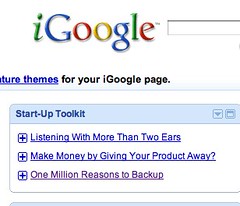Sometimes I get reader questions, and this seemed like a good one to share with readers of the Toolkit. Today I’ll put forward the case, and during the next week, several marketing experts will forward me their opinions and I’ll deliver the results next week in part 2.
Matt Pollitt, CEO of PTE Golf told me “We run a golf company that sells tournament enhancement items to country clubs for their first tee area such as embroidered table covers and special tournament cases for their starters areas. We have never done any marketing with the company, only doing 1-3 trade shows a year. Otherwise, all of our business is word of mouth.”
He also noted “We’ve never marketed to past clients and I think that is a big mistake. We do get reorders, but our contact info has changed over the years.” So unless customers actively look for his website, they can’t reorder via the old phone number.
Matt wanted to know the best way to connect with his old customers. Some of the contacts at the golf clubs may have changed. One thought he had was a post-card mailer, since he has the addresses and contact info for all his previous customers.
Whatever method he chooses should allow him to make customers aware of new products, while also generating inquires and reorders.
How would you help Matt reconnect with old customers? And Marketing folks? Feel free to weigh in via the comments below.
(Originally published at the Inc. Start-up Toolkit part 1) and (part 2)
Two weeks ago, I put forth the case of Matt Pollitt of PTE Golf and his challenge — lack of follow up marketing with his customers, and a change of phone number and address.
I asked several marketing experts to comment, and here I’ve provided some of their responses.
Hart Hooton, President of Marketechnique.com suggested,
“Matt should send a ‘We’ve moved and forget to tell you’ mailer — done in a format that keeps it fun. Then come up with a humorous way to follow this up. Try getting a temp or intern to follow up the mailer with calls to everyone on your list. Don’t forget to get the client’s email address. And, do something on the website that references the mailer so that if people go to look it up, they’ll recognize the visual.”
When I contacted the Direct Marketing Association, Neil C. O’Keefe, V.P. Multichannel Segments, gave Matt more than a few ideas.
“You have an advantage over a typical start-up in that you already have an existing customer base. Since you have their contact information, whether you realize or not you now have a database – albeit a very simple one. Add the date of the event and the dollar amount they spent with you and how long ago? If you have their email address, add that too. And by all means ask for the email going forward and be sure to store that information. If your budget allows – do that mailing you considered to your full file of contacts. If resources are tight you can prioritize by dollars spent and how long ago. A recent customer and a high dollar customer are more likely to respond.”
Neil had a lot more to say, including suggestions to advertise in the trade magazines around the trade shows PTE already attends “Advertising here would also spread the word and allow you to more broadly communicate your 800#, Web address, email, and potentially LinkedIn/Twitter/Facebook pages. Also consider making a Golf blog, where readers contribute to the conversation without turning it into an infomercial. You have a wealth of experience and there are many people who can benefit from what you have to say.”
Finally, Belinda Lang, VP, Marketing Strategy at American Express tells Matt,
“As you put together your plan to reconnect with former customers, thank them for the business in the past, and if you have the information, include some reference to what they had purchased, and for how many years they were a customer. Tell them about something new added to your product lineup, and add an incentive for coming back and buying again from you. Finally, let them know you would love to hear from them with any feedback or suggestions. Like any good relationship, you want to recognize them, give them a reason for engaging with you and demonstrate that you are listening. They may even end up talking about you with their friends.”
Matt, hopefully these 3 experts have given you some things to think about as you reengage with your customers. Check back and let us know what you did, and thanks for letting me use you as a case study.




